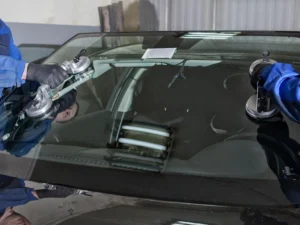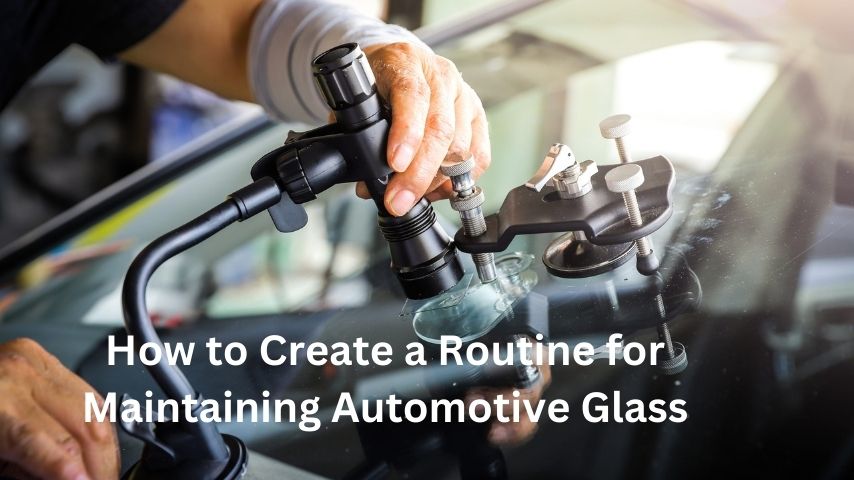Introduction
Maintaining your vehicle is crucial, but often, the condition of automotive glass gets overlooked. Proper care and maintenance of your automotive glass, such as the windshield, windows, and rear glass, can extend its lifespan, enhance safety, and maintain the appearance of your vehicle. In this blog, we’ll guide you through creating a simple yet effective routine for maintaining your automotive glass. This routine is easy to follow, helps prevent costly repairs, and ensures that your vehicle remains safe and roadworthy.
NOTE: Are you looking for expert help with your automotive glass maintenance? Our team of professionals is here to assist you with everything from minor repairs to full replacements. Don’t wait until a small chip turns into a major issue—contact us today for all your automotive glass needs!

Why is Automotive Glass Maintenance Important?
Automotive glass plays several vital roles in your vehicle:
- Safety: Your windshield and windows protect you from the elements and debris. They also provide structural support in the event of a collision.
- Visibility: Clear, clean glass is essential for good visibility. Any chips, cracks, or dirt can obstruct your view and make driving dangerous.
- Aesthetics: Well-maintained glass contributes to the overall appearance of your vehicle. Clean, intact glass looks better and can improve the resale value of your car.
Given these factors, regular maintenance of your automotive glass is not just a matter of aesthetics but also a crucial part of vehicle safety.
Step 1: Regular Cleaning
The first step in your routine is regular cleaning. Clean automotive glass is not only essential for visibility but also helps prevent damage over time.
How to Clean Automotive Glass:
- Use the Right Products: Avoid household glass cleaners that contain ammonia. Instead, use a cleaner specifically designed for automotive glass. Ammonia can damage the tinting on your windows and leave streaks.
- Microfiber Cloths: Use a soft, clean microfiber cloth to avoid scratching the glass. Paper towels or other abrasive materials can leave scratches and fibers behind.
- Clean Both Inside and Outside: Often, we focus on cleaning the outside of the glass, but the inside can accumulate dust and grime as well. Cleaning both sides ensures maximum visibility.
Tip: Clean your automotive glass in the shade to prevent the cleaner from drying too quickly and leaving streaks.
Step 2: Regular Inspections
Inspecting your automotive glass regularly is the next crucial step. This allows you to spot any damage early before it becomes a bigger problem.
What to Look for During Inspections:
- Chips and Cracks: Even small chips or cracks can grow over time. Check your windshield and windows for any signs of damage, especially after driving on rough roads or during extreme weather conditions.
- Seals and Edges: Inspect the edges of your automotive glass where it meets the frame. Ensure the seals are intact, as any gaps can let in water, leading to leaks and further damage.
- Wiper Blades: Worn-out wiper blades can scratch your windshield. Regularly check the condition of your wiper blades and replace them if they are damaged or worn.
Tip: Perform inspections at least once a month or after any significant weather event, such as a storm or extreme heat.
Step 3: Repair Minor Damage Immediately
If you spot any chips or cracks during your inspections, it’s important to address them immediately. Even minor damage can worsen over time, leading to costly repairs or even the need for full replacement.
How to Handle Minor Damage:
- DIY Repair Kits: For very small chips, consider using a DIY windshield repair kit. These kits are available at most auto parts stores and can temporarily fix minor damage.
- Professional Repair: For larger chips or cracks, it’s best to consult a professional. They can assess the damage and recommend the best course of action, whether it’s repair or replacement.
Tip: Many insurance policies cover windshield repairs with little or no deductible, so it’s worth checking your coverage before paying out of pocket.
Step 4: Protect Your Automotive Glass
Prevention is always better than cure, and there are several steps you can take to protect your automotive glass from damage.
Ways to Protect Your Automotive Glass:
- Park in Safe Locations: Avoid parking under trees or in areas where debris can fall onto your car. If possible, park in a garage or covered area to protect your vehicle from the elements.
- Avoid Following Too Closely: On highways, gravel or other debris can be kicked up by the vehicle in front of you. Maintaining a safe following distance can reduce the risk of your windshield being hit by flying debris.
- Use a Windshield Cover: In extreme weather conditions, such as heavy snowfall or intense heat, use a [windshield cover](https://www.neodrift.in/blogs/neodrifts-guide/beat-the-heat-how-to-use-a-windshield-sun-shade-properly?) to protect the glass from damage. This can also make your car more comfortable to drive by reducing the interior temperature.
Tip: During winter, avoid using hot water to defrost your windshield, as the sudden temperature change can cause the glass to crack.
Step 5: Use Quality Products
The products you use to maintain your automotive glass can make a big difference in its longevity.
Choosing the Right Products:
- Glass Cleaner: As mentioned earlier, use an automotive glass cleaner that is ammonia-free and designed for car windows.
- Water Repellent: Consider applying a water-repellent treatment to your windshield. This product causes water to bead up and roll off, improving visibility during rain.
- Windshield Protectant: Some products create a protective layer on your windshield, making it more resistant to chips and cracks.
Tip: Reapply water repellent treatments every few months, especially after heavy use of your wipers, to maintain their effectiveness.
Conclusion
Maintaining your automotive glass doesn’t have to be difficult. By following a regular routine that includes cleaning, inspecting, repairing, protecting, and using quality products, you can keep your automotive glass in top condition. Not only will this enhance your vehicle’s safety and appearance, but it will also save you money in the long run by preventing the need for costly repairs or replacements.
For more insightful articles related to this topic, feel free to visit articlestores.
